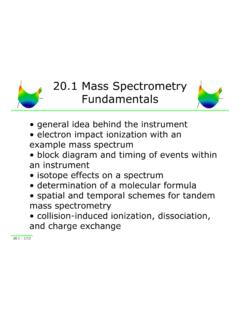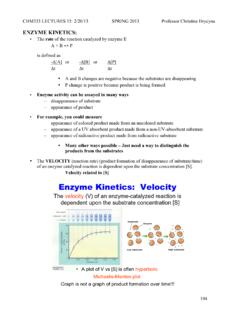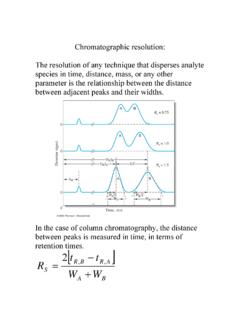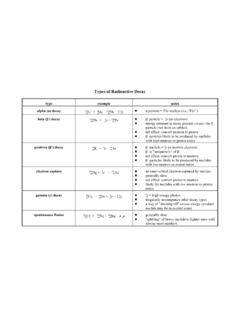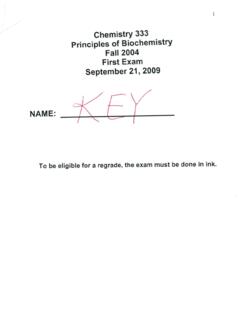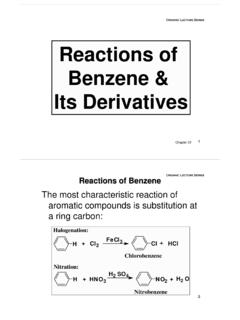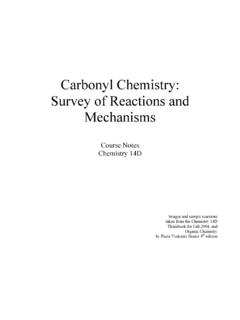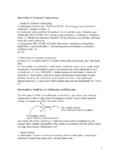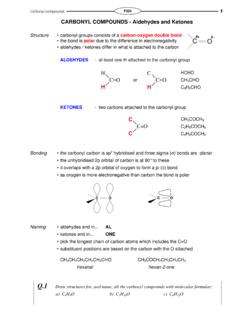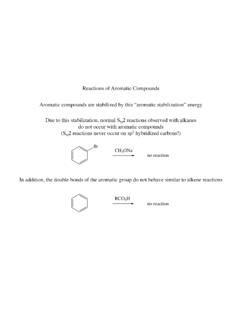Transcription of Ch. 7 - Enolates - Purdue University
1 209 Enolates Enolates are the conjugate anions of carbonyl compounds. Although they have been known and used since the turn of the 20th Century, it was the development of specific Enolates (see below) by H. O. House of MIT in the 1960-1970s that made carbanion chemistry one of the most important tools for stereo- and regio-controlled carbon-carbon bond formation in organic synthesis. That importance continues to this day. Generation of Enolates by deprotonation of carbonyls: OYHB:baseOYOYY=H, alkyl, OR, NR2, SR Relevant acidity data: Compound pKa aldehyde ~20 ketone ~20 cyclic ketone ~17 -dicarbonyl 11-13 ester ~25 nitrile ~25 Compare these pKa s to the basicity values (as conjugate acid pKa s) of common bases: R2N- pKaconj = 35 RO- pKaconj = 16 (R = Me) - 18 R = t-Bu) R3N pKaconj = 9-11 Conclusion: MeOOOMeOpKa = 13 NaOMeMeOH(pKa = 16)MeOOOMeONapKeq = 16-13 = 3 Keq = 103 ONaOMeMeOH(pKa = 16)pKa = 17 ONapKeq = 16-17 = -1 Keq = 10-1 OpKa = 17 OLipKeq = 35-17 = 18 Keq = 1018Li+ -N(i-Pr)2+ HN(i-Pr)2pKa = 35 210 Structure of Enolates A.
2 C- vs O- Metallation MOOM covalent C-M bond (true for electronegative M, Hg++, Cu++, Zn++)ionic O-M bond (electropositive M, Li+, Na+, K+, Mg++)although often drawn as resonance, this is usually tautomerism (a fast equilibrium)note: !-diketones form cyclic chelateROROM B. Aggregation State 1. Although typically drawn as monomeric species, Enolates in solution are usually found as higher aggregates (dimers, tetramers). 2. The exact aggregation state depends on solvent and counterion. LiOLiOOLiLiO generalized structure of solvated tetramer 3. Smaller counterions ( Li+) favor tetramer while larger ones ( K+, Cs+) favor dimer. 4. Et2O favors dimer, but THF and DME favor tetramer. 5. Generally speaking, tetrameric Enolates react as carbon nucleophiles. 6. References: House, J. Org. Chem. 1971, 36, 2361 (original suggestion) Jackman, Tetrahedron, 1977, 33, 273 (NMR studies) Dunitz, Helv.
3 Chim. Acta. 1981, 64, 2617 - 2622 (x-ray st udies) see also J. Am. Chem. Soc. 1985, 107, 5403; Tetrahedron Lett. 1989, 447 211 C. Regiochemistry (which side of carbonyl deprotonates?) OObaseOOmore stableless stableOObaseOOOO more stableless stablebaseOOmore stableless stable D. Stereochemistry ObaseOOZ-enolateE-enolateORObaseROOMROOM Z-enolateE-enolateE-enolateZ-enolate(M = Li)(M = Li) 212 XCH3 OLDAS tereochemistry of DeprotonationXCH3 OLiXOLiCH3+"Z""E" X E Z OMe 95 5 Ot-Bu 95 5 Et 77 23 i-Pr 40 60 t-Bu 0 100 Ph 0 100 NEt2 0 100 Large X yields Z 213 II. Generation of Enolates A. Deprotonation of active hydrogens 1.) Thermodynamic conditions ONaOMeMeOHO Na+ MeOH Keq = 10-2 (favors ) MeOOMeOONaOMeMeOHMeOOMeOONa+MeOH essentially irreversible eq LDAO Li equilibrium established with OO NaNaHWhy an Equilibrium?
4 2.) Kinetic conditions OONH2 irreversible KNH2, LiNH2, and NaNH2 are insoluble in organic solvents so LiNR2 was developed R = Et, i-Pr, (i-Pr, cyclohexane), or t-Bu development of specific Enolates : House, JOC, 28, 1963, 3362 30, 1965, 1341, 2502 34, 1969, 2324 214 3.) Regiochemistry of deprotonation O1) LDA2) TMS-Cl1) Et3N2) TMS-ClOTMSOTMSOTMS84%7%9%13%58%29%kineti cthermo. OO LiO KLDAt-BuOKt-BuOHor KH or LDA/HMPA(9:1) thermo.> 95% kinetic HHOHHTMSOHHTMSO+1) Ph3C Li2) TMS-Cl13%87%53%47%1) .95 (eq) Ph3C Li 2) HMPA, TMS-Cl 4.) Stereochemistry of deprotonation RCH3 ORCH3 OMZROMCH3E House, JOC, 1963, 28, 3362 215 How to Determine? Make Si(CH3)3 ether: 1H-NMR, 13C NMR (Heathcock, JACS, 1979, 44, 429) nOe (Oppolzer, TL, 1983, 24, 495) Ireland does Claisen: OOOOTMSOOTMSOOTMSOOTMSCO2 TMSOOTMSOOTMSCO2 TMSZE[3,3][3,3]synanti Ex: OC H3O Libase+O LiC H3ZE14 9223358687765::::baseN'', HMPALDA (-78 )LICA (-78 )Li(-78 ) Why kinetic preference for E?
5 216 Look at for deprotonation: JACS, 1976, 98, 2868 NHOLiR'R'RHnot badNHOLiR'R'HR"1,3 diax." e- 's abstracted proton to ! system "EZ NHOLiR''RHNHOLiR''RRRROO favorable unfavorableRHaHbHbO-Hb-HaThis view of the accounts for both stereo- and regio- specificity R = CH3 99:1 R = Ph 99:1 R = OCH3 85:15 R = NMe2 98:2 217 NHOLiR'R'XHMeEZLiNR'2 NHOLiR'R'XMeHOHMeHXA(1,2)For acyclic ketones, we have A(1,2) strain to considerXMeO XMeOLDAXE:ZOCH3Ot-BuEti-Prt-BuPhNEt295:5 95:577:2340:600:1000:1001:100increasingb ulk of XAll 3o amides give Z-enolatescaveat: need conditions in whichLi coordinates O ( , no HMPA, 18C-6, polar solvents) Stereoselectivity of LDA/HMPA w/ ketones; esters - Ireland, JOC,1991, 56, 650-657 218 Reactions Of Enolates Enolates = functionalized carbon nucleophiles (Others are CN, CCR, RMgX, RLi) react with electrophilic carbon 2 types: CXOsp3 First type gives enolate alkylation Enolate Alkylation OMRXSN2RO+M X (note: X must be Br, I, OTs, OMs or OTf to get decent reactivity) Considerations: C- vs.
6 O- alkylation Enolates are ambident nucleophiles; can react at C or O ORXROOR abab What influences C- vs. O- ratio? House, JOC, 1973, 38, 515 219 a. hard/soft electrophiles O"hard" anion (localized)"soft" anion (delocalized) C- alkylation with soft electrophiles (R-I, R-Br) OMAlso, O-M bond affects C/O ratio (As O-M covalent, O is less reactive) (As O-M ionic, O is more reactive) So: Li Na K NMe4C/O ratiocovalentionicrate cyclic -diketones are especially hard OOOOHOOOO+BrK2CO3 DMFvinylogous acid37%15%O-C- Also phenolates: O NaPhCH2 BrDMFOPh97% 220 b. Solvent polar, aprotic solvents (HMPA, DMSO, DMF) solvate M+ ion make naked anion (very hard) favors O- alkylation O NaPhCH2 BrCF3CH2 OHOHC H2Ph solvents which promote aggregation ( , THF) favor C-alkylation by making enolate less accessible c.
7 Structure of electrophile OEtOOR-BrneatOEtOOR+OEtOROR=n-Pri-PrBrPh CH2Br9773100100::::32700 Why? Hindered carbon is harder Conclusion - Usually, use Li+ enolate in THF Ex: O LiORR-XTHF also, R will usually be methyl, 1 , allylic, benzylic, (2 gives elimination) X = -Br, -I -When reactivity is a problem, we can increase rate using K+ as counterion (but run the risk of competing reactions arising from basicity of enolate)
